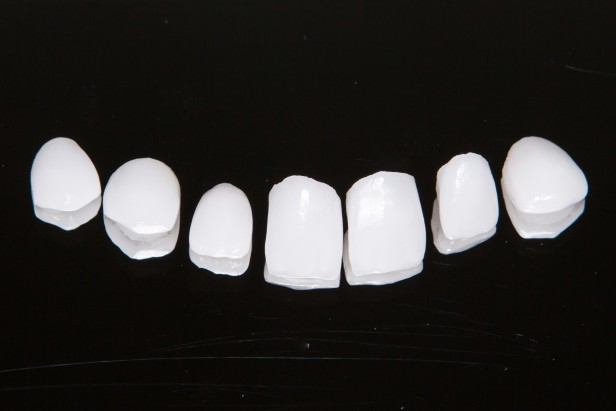Veneers and crowns are two types of restorative solutions that can be used to save your smile. They can both improve the appearance and function of your teeth. Because they seem to provide the same benefits, many people assume that veneers and crowns are the same thing. However, while these two treatments may seem similar, there are some major differences between them. To help you figure out which dental restoration method is right for you, here is a glimpse at the difference between veneers and crowns, how they work, and when each method should be used.
What Are Porcelain Veneers?
Porcelain veneers are made from thin layers of fine, stain-resistant dental porcelain and are usually only about one millimeter thick. Veneers are a noninvasive cosmetic dentistry option, with the procedure leaving most of your existing tooth intact. They are custom designed for each patient so that they securely cover the front surface of your tooth. To prepare your tooth for a porcelain veneer, your dentist will grind down about half a millimeter of the enamel on the front of your tooth to make it easier for the veneer to bond, as the cement will stick best to a rougher surface. However, the amount of enamel that needs to be filed down can vary depending on the type of veneer. It is important to note that a veneer can only be placed on a tooth that has plenty of existing enamel.
What Are Dental Crowns?
A dental crown completely covers the entire tooth, which means more of the tooth will need to be filed down before a crown can be placed. Crowns are typically used to restore teeth that have been badly damaged by decay, cracks, or fractures. If tooth decay is the reason you need a dental crown, your dentist will need to remove the decayed part and possibly rebuild some of the tooth so that it can support the crown. Dental crowns are usually molded from either porcelain, porcelain fused to a metal alloy (PFM), or an all-metal alloy. Your dentist will fabricate the crown to securely fit over your tooth and then cement it into place.
Veneers vs Crowns: How Are They Similar?
Both veneers and crowns are dental treatments that improve the appearance and function of teeth. They are typically used to restore teeth that are somehow damaged, whether discolored, crooked, decayed, chipped, cracked, or broken. Veneers and crowns are both made to match the color of the rest of your teeth—with the exception of all-metal crowns—to give you a seamless, complete smile. Once they are applied, it’s difficult to tell the difference between a veneer and crown because they will each have a similar effect on your smile. You will care for both veneers and crowns virtually the same way. You’ll need to brush them twice a day just like the rest of your teeth and floss to remove food particles. Regular dentist visits will also be needed for professional cleaning and to check the restorations.
Veneers vs Crowns: How Are They Different?
The biggest difference between veneers and crowns is how they fit your tooth and the reason behind needing them. A porcelain veneer is bonded to just the front surface of your tooth, while a dental crown covers your entire tooth. This tends to make veneers more aesthetically pleasing than crowns because they show less gum margin. Crowns are thicker than veneers—two millimeters compared to one millimeter—and are more permanent. Veneers may need to be replaced after a certain number of years, but crowns may be able to last most of your life.
How Much Do Veneers and Crowns Cost?
Porcelain veneers can typically cost anywhere between $925 and $2,500 per tooth. Dental crowns, on the other hand, usually fall in the range of $1,000 to $3,500 per tooth. Porcelain and ceramic crowns are more expensive than their all-metal counterparts. However, dental insurance will often cover part of the cost of crowns, but it will not usually cover the cost of veneers since they are considered cosmetic. Whether you need a veneer or crown, your dentist will likely be able to provide a payment plan to make the dental treatment easier for you to afford.
Is a Veneer or Crown Right for Me?
Since veneers and crowns seem to provide basically the same function, they can be used interchangeably, right? Actually, no. Your dentist will recommend one dental treatment option over the other based on your specific situation. Dental crowns are typically the best option if your tooth is very damaged, has a large filling, or has undergone a root canal, since the tooth enamel is more compromised and will need better protection. Porcelain veneers, on the other hand, are best for purely cosmetic purposes. If your tooth is mostly intact and only needs minor shape correction or an improved appearance, then your dentist will likely recommend porcelain veneers.
Restorative and Cosmetic Dentistry in Knoxville, TN
Do you have a tooth or multiple teeth that need correcting? Here at University General Dentists, our experienced dentists can help you determine whether porcelain veneers, dental crowns, or other treatment options are best for you. Whether your tooth needs to be fully restored with a crown or you just want to improve the appearance of your smile with a natural-looking set of porcelain veneers, we can provide you with the restorative and cosmetic dentistry services you need to achieve a healthy, beautiful smile. We offer an array of full-mouth reconstruction treatment options as well as multiple cosmetic dentistry procedures that can help you achieve a smile that you’ll be proud to show off.
Give University General Dentists a call today to schedule an appointment at one of our two convenient Knoxville dentist locations. You can reach our University of Tennessee Medical Center office at 865-305-9440 or our West Knoxville office at 865-500-5700.

